The complicity of Wall Street
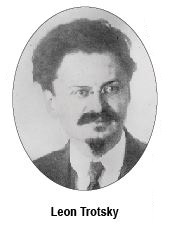 Many books and articles have been written in the attempt to prove complicity between the world of International Finance and Bolshevik revolutionaries. In the 1970’s, however, the United States State Department Decimal File (861.00 section) was discovered. It contains extensive documentation on the various business arrangements between the banking moguls and Bolshevik revolutionaries.
Many books and articles have been written in the attempt to prove complicity between the world of International Finance and Bolshevik revolutionaries. In the 1970’s, however, the United States State Department Decimal File (861.00 section) was discovered. It contains extensive documentation on the various business arrangements between the banking moguls and Bolshevik revolutionaries.
This article, with information taken from Anthony C. Sutton’s book Wall Street and the Bolshevik Revolution, will discuss evidence merged with biographies, personal papers and conventional history, of which combination reveals a truly riveting (and factual) drama.
The United States and Canada
“Dear Mr. President:
I am in sympathy with the Soviet form of government as that best suited for the Russian people...” Letter to President Woodrow Wilson (October 17, 1918) from William Lawrence Saunders, chairman, Ingersoll-Rand Corp., deputy chairman of the Federal Reserve Bank of New York.
The Bolshevization of Wall Street was known among well-informed circles as early as 1919. President Woodrow Wilson was the “fairy godmother” who provided Leon Trotsky (called by the New York Times an “exiled Russian revolutionist”) with an American passport to return to Russia in order to promote the revolution. The German Imperial Bank also provided him with $10,000 to support the cause of the Bolsheviks, during his stay in New York. Trotsky was accompanied in his voyage to Russia by other revolutionaries, including Vladimir Lenin, Wall Street financiers, American Communists and others on the S.S. Kristianiafjord.
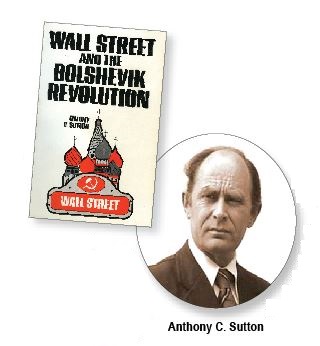 During their stop in Canada, Trotsky was detained overnight and the documents that prove his possession of an American passport can be obtained from Canadian government archives. His detention was revoked upon receiving a telegram from the Washington State Department. In the Trotsky affair, we have two American residents corresponding with a Canadian deputy postmaster general in order to intervene on behalf of an interned Russian revolutionary.
During their stop in Canada, Trotsky was detained overnight and the documents that prove his possession of an American passport can be obtained from Canadian government archives. His detention was revoked upon receiving a telegram from the Washington State Department. In the Trotsky affair, we have two American residents corresponding with a Canadian deputy postmaster general in order to intervene on behalf of an interned Russian revolutionary.
Lieutenant Colonel John Bayne MacLean, a prominent Canadian publisher and businessman, founder and president of MacLean Publishing Company, Toronto, put forth an article in 1918 entitled: “Why did we let Trotsky go? How Canada lost an opportunity to shorten the war.” MacLean’s opening argument is that “some Canadian politicians or officials were chiefly responsible for the prolongation of the war (World War I), for the great loss of life, the wounds and sufferings of the winter of 1917 and the great drives of 1918.” He continues on to say that propaganda made it impossible for the Canadian Parliament and Canadian citizens to get any true facts about this matter. It was completely hidden from the public eye.
Colonel MacLean made observations that Trotsky had “strong underground influence” and that his power “was so great that orders were issued that he must be given every consideration.”
Connections with Germany
“It was not until the Bolsheviks had received from us a steady flow of funds through various channels and under varying labels that they were in a position to be able to build up their main organ Pravda, to conduct energetic propaganda and appreciably to extend the originally narrow base of their party.” Von Kuhlmann, minister of foreign affairs, to the Kaiser, December 3, 1917
In the year 1917, Lenin traveled by train from Switzerland through Germany and Sweden to Petrograd, Russia... along with a party of Russian Bolshevik revolutionaries to complete the revolution details. They were joined by Leon Trotsky.
Lenin’s voyage to Russia was part of a plot approved by the highest level of the German Supreme Command. Chancellor Theobald von Bethmann-Hollweg, a German political officer, was also a descendant of the Frankfurt banking family. The idea of using Russian revolutionaries can be recorded all the way back to 1915, and it was J.P. Morgan and the American International Corporation that were attempting to control all domestic and foreign revolutionaries that may have entered into the United States.
The preparations for the Bolshevik Revolution itself were well known at least six weeks in advance. One report from the State Department files observes that it was “doubtful whether government... [can] suppress an outbreak.”
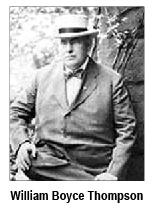 Wall Street and World Revolution
Wall Street and World Revolution
Before World War I, the financial and business world in the United States was being run by Rockefeller and J.P. Morgan. They also dominated Wall Street, and often used financial backing to promote revolution, with the purpose of establishing control over that country’s industry. For example, the purpose of the revolution in Colombia was to acquire $40 million dollars and to gain control of the Panama Canal. In China, the banking moguls were promised by the revolutionaries a major part in the railroad, banking and commercial industries. In Mexico in 1916, the Carranza government was supplied by Wall Street with thousands of dollars worth of ammunition to aid in the revolution, with a view to obtaining corporate interests in Mexico. This is exactly what happened.
When the Morgan house floated war loans for Britain and France in 1915, J.P. Morgan argued that these were not war loans at all but merely a means of facilitating international trade. These financial institutions flagrantly ignored the law which states that financial backing cannot be given to warring countries. Olaf Aschberg, a Swedish banker and head of the Nya Banken in Stockholm, arranged loans for Morgan-Rockerfeller and so became known as the “Bolshevik Banker” and his own memoirs reproduce evidence of his rights to the title.
Aschberg stated that: “The opening for American capital and American initiative, with the awakening brought by the war, will be country-wide when the struggle is over. There are now many Americans in Petrograd, representatives of business firms, keeping in touch with the situation, and as soon as the change comes a huge American trade with Russia should spring up.”1
The American Red Cross : Mission in Russia
“Poor Mr. Billings believed he was in charge of a scientific mission for the relief of Russia... He was in reality nothing but a mask – the Red Cross complexion of the mission was nothing but a mask.” Cornelius Kelleher, assistant to banker William Boyce Thompson (in George F. Kennan, Russia Leaves the War).
The Wall Street project in Russia in 1917 used the Red Cross Mission as its operational vehicle. During World War I, the Red Cross depended heavily on Wall Street and specifically on the Morgan firm. These bankers viewed the Red Cross as a sort of “virtual arm of government.” On May 29, 1917, the idea of the Red Cross Mission was conceived specifically so that a delegation of lawyers and financiers, using assumed military titles for the occasion, could be sent to Russia at the expense of the Federal Reserve Bank of New York.
The Red Cross Mission was headed by “Colonel” William B. Thompson, a director of the Federal Reserve Bank. From its personnel, it is obvious that it would have been more appropriate for it to have been called a commercial or financial mission, but from its actions, it was also a subversive political action group. The legitimate group of doctors who were attached to the group quit in disgust shortly upon arrival to Russia, protesting the political activities of Thompson and his cronies. Thompson’s contribution to the Bolshevik revolution was also recorded in the Washington Post on February 2, 1918.
The desire of the American financiers was to gain “control of the surplus resources of Russia and have control officers at all points on the frontier.”2
Without the help of the financiers, notably Thompson and his New York associates, probably the Russian revolution would never have happened. Germany, as a major economic and commercial enemy, was also paying close attention to the profits that Russia had in its vast territories. This was making the financiers very nervous, and so they hastened to invest large amounts of money in the revolution. Raymond Robins, who worked closely with Thompson, made this comment to Bruce Lockhart, a British agent: “Let us assume that I am here to capture Russia for Wall Street and American Businessmen.”3
To outwit Germany, Thompson was willing to place seed money on any political power vehicle that would achieve his objective. He attempted to convince the Russian peasants to support Alexander Karensky by investing $1 million of his own money and US government funds of the same order of magnitude in propaganda activities.
Thompson had several fellow directors who had an interest in the Bolshevik revolution, such as George Foster Peabody, who was deputy chairman of the Federal Reserve Bank of New York and a close friend of socialist Henry George. Peabody and his fellow financiers in Washington could achieve government control more easily through the acquisition of commercial enterprises. Think of it – one gigantic state monopoly!
Many messages flew through Washington because of the support of President Woodrow Wilson. Here is one example: “President’s message to Consul Moscow not understood here and people are asking why the President expresses support of Bolsheviki, in view of rapine, murder and anarchy of these bands.”4
Allied governments paralyzed their own representatives. Not only that, but the Wilson administration also ignored all entreaties from the people to stop the financial and commercial support of the Bolsheviks! This led to the resignation of several top government officials, including De Witt C. Poole, who was in charge in Archangel (Russia).
The American International Company
Frank A. Vanderlip has described in his memoirs how American International was formed and the excitement created on Wall Street over its business potential.5
Stone & Webster – the international railroad contractors who “were convinced there was not much more railroad building to be done in the United States” decided to look to other countries for profit, and so, by 1916 AIC (American International Company) was formed. AIC’s investments overseas amounted to more than $23 million in 1916 and to more than $27 million in 1917. They were operating on a major scale in Australia, Argentina, Uruguay, Paraguay, Colombia, Brazil, Chile, China, Japan, India, Ceylon, Italy, Switzerland, France, Spain, Cuba, Mexico and other countries in Central America.
AIC also invested in United Fruit Company, which was involved in the Central American revolution in the 1920s. (Notably Ecuador, as we mentioned in last month’s article in MICHAEL by John Perkins). AIC and other corporations such as these had an interest in the continuation of World War I.
What is interesting is the association between the directors of the Federal Reserve Bank, American International Corporation, and the emerging Soviet Russia.
William Sands of American International, who was also a director of the Federal Reserve Bank of New York, contributed $1 million to the Bolsheviks. Within a matter of weeks after this donation, the revolution started. That shows how the endorsement of the directors of the Federal Reserve Bank and J.P. Morgan Bank was at the very least consistent.
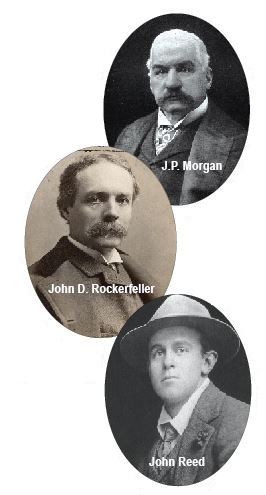 J.P. Morgan Bank and John Reed
J.P. Morgan Bank and John Reed
John Reed was a socialist writer backed by J.P. Morgan Bank and who worked for Harry Payne Whitney’s Metropolitan Magazine. Reed contributed many articles in favour of Mexico’s revolution that was started with Pancho Villa. Villa’s revolution was supported by the American company Guaranty Trust; they supplied him with ammunition for the revolution. This revolution was one the bloodiest in the history of Mexico. (See article from our last MICHAEL Journal.)
One of his pieces entitled “At the Throat of the Republic” (Masses, July 1916), traced the relationship between munitions industries, the national security-preparedness lobby, the interlocking directorates of the Morgan-Rockefeller interest, “and showed that they dominated both the preparedness societies and the newly formed American International Corporation, organized for the exploitation of backward countries.”6
Guaranty Trust goes to Russia
Telegram: “Soviet Government desire Guarantee [sic] Trust Company to become fiscal agent in United States for all Soviet operations and contemplates American purchase Eestibank with a view to complete linking of Soviet fortunes with American financial interests.”7
In 1918, the Soviets were faced with a very difficult problem. They were in need of foreign arms, imported food, and financial support. Above everything else, they needed foreign trade.
New York bankers and lawyers provided the necessary help for all of these needs. When George V. Lomonossoff, a Russian technical expert in the Soviet Bureau, needed to transfer funds to a Bolshevik agent in Scandinavia named Michael Gruzenberg, a prominent Wall Street lawyer came to his rescue.8
It was the commercial exploitation of Russia that excited Wall Street and they lost no time in preparing their program. An executive committee consisting of representatives of the U.S. Congress, domestic revolutionary elements and financial interests, was set up in 1918. Guaranty Trust and International American Company were among the “investors” in this exploitation.
These two companies were run by Wall Street financiers, who were not afraid to play both sides of the revolution. In 1919, J.P. Morgan and other prominent New York bankers financed Admiral Aleksandr Kolchak, an anti-Bolshevik. Obviously, banker funds have no national flag!
What motive explains this coalition of capitalists and Bolsheviks?
The great country of Russia was, in the 1900s and is still today, one of the largest unexploited markets in the world. It is also still the largest possible threat in competing markets to any industrial or financial supremacy, especially to the American financial institutions.
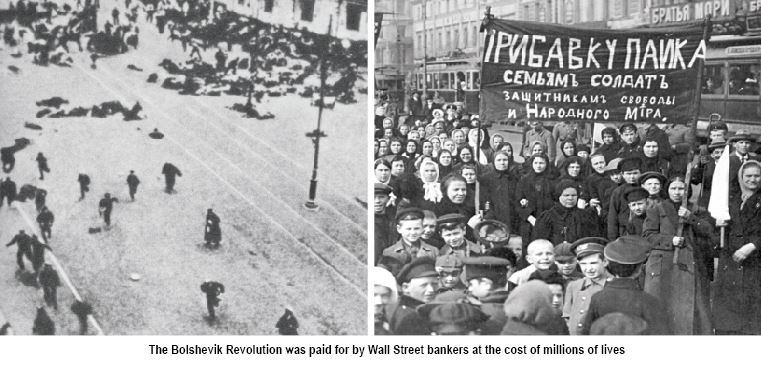
What was/is the goal of the Wall Street bankers?
Their goal was, and still is, to entrap the Russian market into their possession and to create a technical area that will be under the control of American financiers, as well as corporations that are under them.
The International Commerce Commission and the Federal Trade Commission, in the hands of the financiers, continued to advance the agenda of Wall Street. These financiers were, and continue to be, power-motivated and they will support and acknowledge anyone who will allow them a seat in power: Trotsky, Lenin, Kolchak, Marx, Pancho Villa, Mao Zedong, and many others throughout history. They are willing to support anything but a free and sovereign society.
The governments of the world were, and are, to be socialized while the ultimate power remains in the hands of the International financiers “to control its councils and enforce peace [and so] provide a specific (plan) for all the political ills of mankind.”9
This handful of bankers and promoters are not Bolshevik, Communist, socialist, Democrat, or even American. Above all, these men want markets, preferably captive international markets – and a monopoly of the captive world market as the ultimate goal. They want markets that can be exploited monopolistically without fear of competition from Russians, Germans, or anyone else – including American businessmen outside the charmed circle. This closed group is amoral and apolitical.
Today their objective is alive and well.
CORRECTION
In regards to the article entitled: “The complicity of Wall Street” by Anthony B. Sutton – Vladimir Lenin was not a member of the party that included Leon Trotsky who traveled on the S.S. Kristianiafjord. Lenin was in Switzerland until April of 1917. We apologize for the error.
1.) New York Times, August 4, 1916.
2.) Bullard ms., U.S. State Dept. Decimal File, 316-11-1265.
3.) U.S. Senate, Bolshevik Propaganda, Hearings before a Subcommittee of the Committee on the Judiciary, 65th Cong. 1919, p. 802.
4.) U.S. State Dept. Decimal File, 861.00/1305, March 15, 1918.
5.) Frank A. Vanderlip, From Farm Boy to Financier (New York: A. Appleton-Century, 1935).
6.) Granville Hicks, John Reed, 1887-1920 (New York: Macmillan, 1936), p. 215.
7.) William H. Coombs, reporting to the U.S. embassy. in London, June 1, 1920 (U.S. State Dept. Decimal File, 861.51/752). (“Eestibank” was an Estonian bank).
8.) U.S. Senate, Russian Propaganda, hearings before a sub-committee of the Committee on Foreign Relations, 66th Cong., 2d sess., 1920.
9.) Jennings C. Wise, Woodrow Wilson: Disciple of Revolution (New York: Paisley Press, 1938), p. 46.
